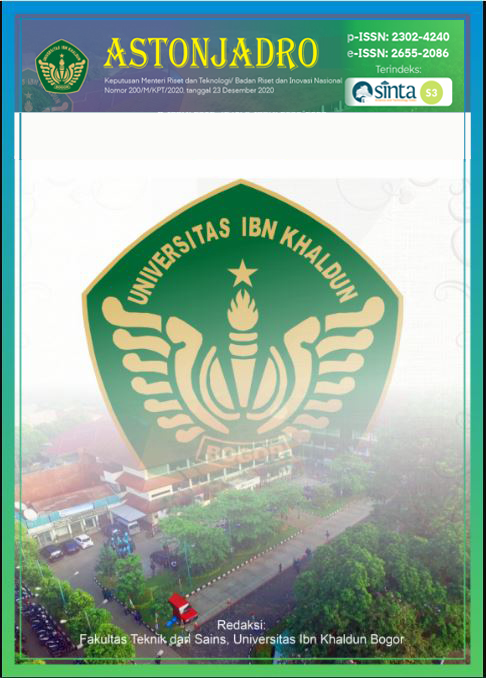Study of Preferences and Economic Aspects of Low-Income Housing Development (LIC) in Batangkuis Sub-District
DOI:
https://doi.org/10.32832/astonjadro.v13i2.15541Keywords:
home ownership; LIC; economic aspects; Batangkuis.Abstract
The rapid growth and development of major cities in Indonesia has resulted in regional growth and the formation of a class of Low-Income Communities (LIC) and the problem of providing housing for them. This study was conducted to identify the preferences of low-income housing ownership as well as to examine the development of low-income housing in terms of economic aspects. A quantitative approach was taken for LIC home ownership preferences and qualitative for LIC housing development prospects from an economic aspect. The results showed that home ownership preferences and the willingness of LIC to pay for housing units were influenced by variables of residential typology in the form of a single detached house, affordable prices with the ability to pay for LIC, convenient location, provision of basic housing facilities and infrastructure, good quality with attractive designs without affecting the price and supported by the availability of financing institutions that provide installment scheme facilities. LIC housing development in Batangkuis District in terms of economic aspects shows promising prospects in terms of supply by developers where land prices and financing along with construction costs as well as licensing and other legalities are still below the selling price set by the government. The availability of banking financing institutions that help facilitate financing also supports developers in marketing and sales. Meanwhile, from the side of LIC consumers in Batangkuis Sub-district, the availability of financing institutions has no effect because of the gap between the concept of financing and their economic capacity. The amount of monthly installments and initial financing is quite large, making them unable to access subsidized LIC housing developed in Batangkuis District.
References
Cai, W., & Lu, X. 2015. Housing Affordability : Beyond the Income and Price Terms, using China as a Case Study. Habitat International, vol 47, pp 169-175, doi:10.1016/j.habitatint.2015.01.021
Farraz, M. A., & Barus, L. S. (2019). Housing Preferences and Choice Young Families Commuters in Depok City, Indonesia. IOP Conference Series: Earth and Environmental Science, 264(1), [012010]. https://doi.org/10.1088/1755-1315/264/1/012010
Hutapea, H & Suwandono, D. 2014. Perencanaan pembangunan perumahan baru dan strategi pengadaan tanah bagi Masyarakat Berpenghasilan Rendah di Kecamatan Banyumanik . Jurnal Ruang, vol. 2, no. 4, pp. 371-380, ISSN 1858-3881
Indradjati, P.N, (2020).”Peraturan Zonasi Sebagai Perangkat Kolaboratif Mewujudkan Perumahan untuk Masyarakat Berpendapatan Rendah Di Kawasan Perkotaan”. Jurnal Permukiman, vol. 15, no. 2, pp 61-72, doi:10.14710/pwk.v9i3.6542
Kementerian Pekerjaan Umum dan Perumahan Rakyat. 2020. Dinamika Pengembangan Perumahan Skala Besar. Jakarta : Direktorat Sistem dan Strategi Penyelenggaraan Perumahan Kementerian Pekerjaan Umum dan Perumahan Rakyat, p.7 , ISBN : 978-623-92286-5-1
Kementerian PPN/Bappenas. 2015. Indonesia: A Road Map for Housing Policy Reform. Jakarta: Direktorat Permukiman dan Perumahan.
Lisnawati. (2015). “Kebijakan Anggaran dan Skema Pembiayaan dalam Mengatasi Backlog Perumahan. Info Singkat Ekonomi dan Kebijakan Publik Pusat Pengkajian Pengolahan Data dan Informasi. vol. 7, no. 14, pp. 13-16, https://berkas.dpr.go.id/puslit/files/info_sing kat/Info Singkat-VII-14-II-P3DI-Juli-2015- 77.pdf.
Marisa, A & Talarosha, B (2020). Analyzing important work motivators for architects in the project delivery processIOP Conf. Series: Earth and Environmental Science 452, doi:10.1088/1755-1315/452/1/012083
Nugroho, I. & Dahuri, R. 2012. Pembangunan Wilayah Perspektif Ekonomi, Sosial dan Lingkungan. Jakarta: Penerbit LP3ES.
Omolola, O. O., & Ayoride, O. S. 2016. Socio-Economic Correlates of Housing Finance Strategies in Ibandan, Southwest, Nigeria. Procedia - Social and Behavioral Sciences, vol. 216, pp. 295-305. doi:10.1016/j.sbspro.2015.12.041
Pakpahan, Deddy H. 2015. The Three Musketeers, Solusi Atasi Backlog Perumahan di Indonesia. Dalam http://jktproperty.com/three-musketeers-solusi-atasi-backlog-perumahan-di-indonesia/
Ram, P., & Needham, B. 2016. The Provision of Affordable Housing in India: Are Commercial Developers Interested?. Habitat International, vol 55, pp. 100-108, doi:10.1016/j.habitatint.2016.03.002
Sharfina, S. (2015). Dampak Pembangunan Bandara Kualanamu Terhadap Nilai Tanah (Studi Pada Kantor Kecamatan Beringin, Kabupaten Deli Serdang). Perspektif, 4(1).
Shi, W., Chen, J., Wang, H. (2016). Affordable housing policy in China: New developments and new challenges, Habitat International, vol. 54, no 3, pp. 224-233, ISSN 0197-3975, https://doi.org/10.1016/j.habitatint.2015.11.020.
Tunas, D. & Peresthu, A. (2010). “The Self-help Housing in Indonesia: The Only Option for The Poor?” Habitat International, vol. 34, no. 3, pp. 315–322, doi: 10.1016/j.habitatint.2009.11.007
United Nations (1976). Housing Policy Guidelines for Developing Countries. United Nations Department of Economic and Social Affairs, United Nations Report ST/ESA/ 50, New York. P. 60.
Yudohusodo, S. (1988). “Pembangunan Kota Baru dan Kota Satelit”. Seminar Nasional Kota Baru dan Kota Satelit Semarang, 29 Oktober 1988
Downloads
Published
How to Cite
Issue
Section
License
Copyright (c) 2024 ASTONJADRO

This work is licensed under a Creative Commons Attribution-ShareAlike 4.0 International License.
Paper submitted to ASTONJADRO is the sole property of the Astonjadro Journal. Unless the author withdraws the paper because he does not want to be published in this journal. The publication rights are in the journal Astonjadro.ASTONJADRO
LICENSE
This work is licensed under a Creative Commons Attribution-ShareAlike 4.0 International License.
Based on a work at http://ejournal.uika-bogor.ac.id/index.php/ASTONJADRO













